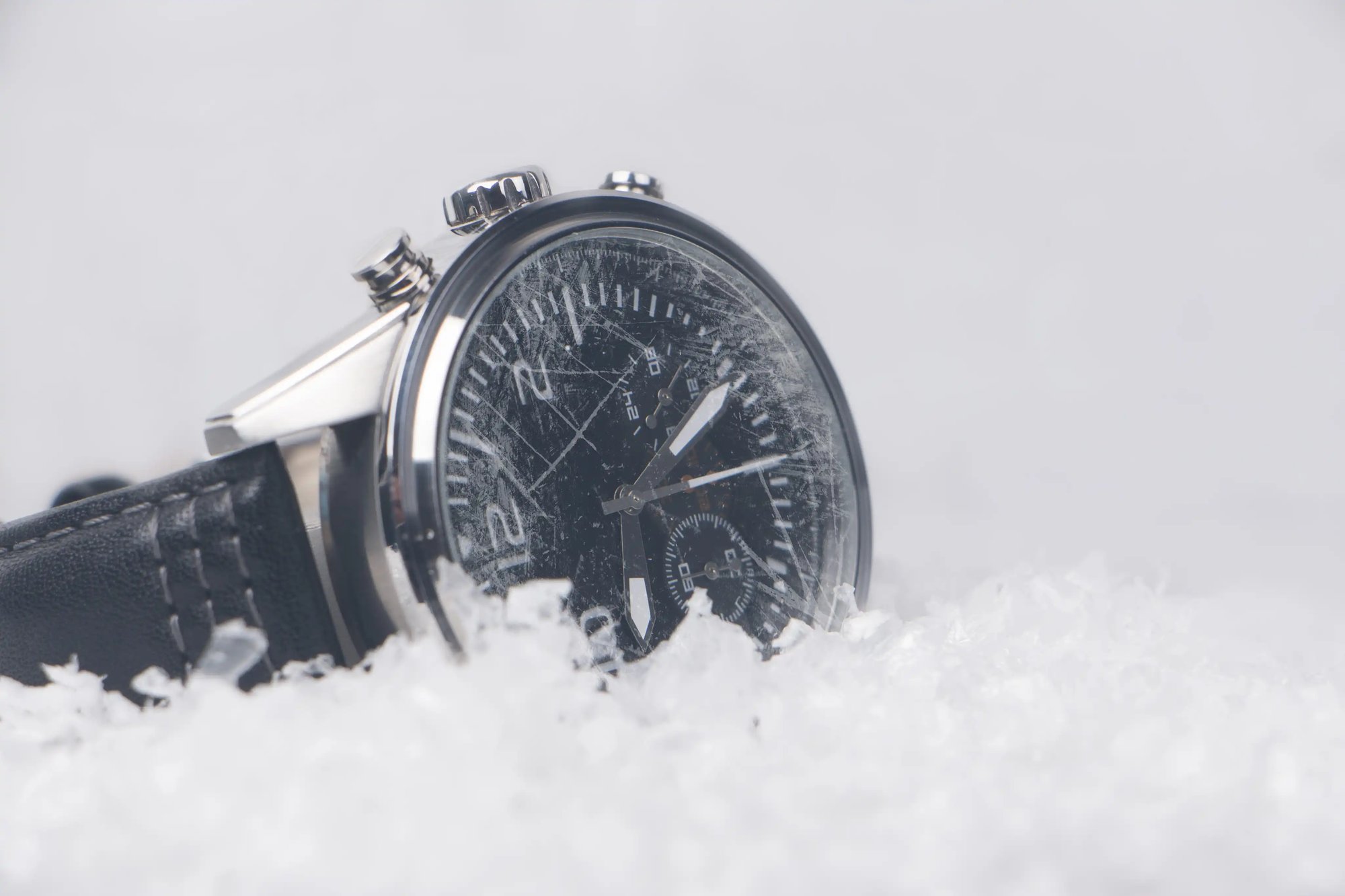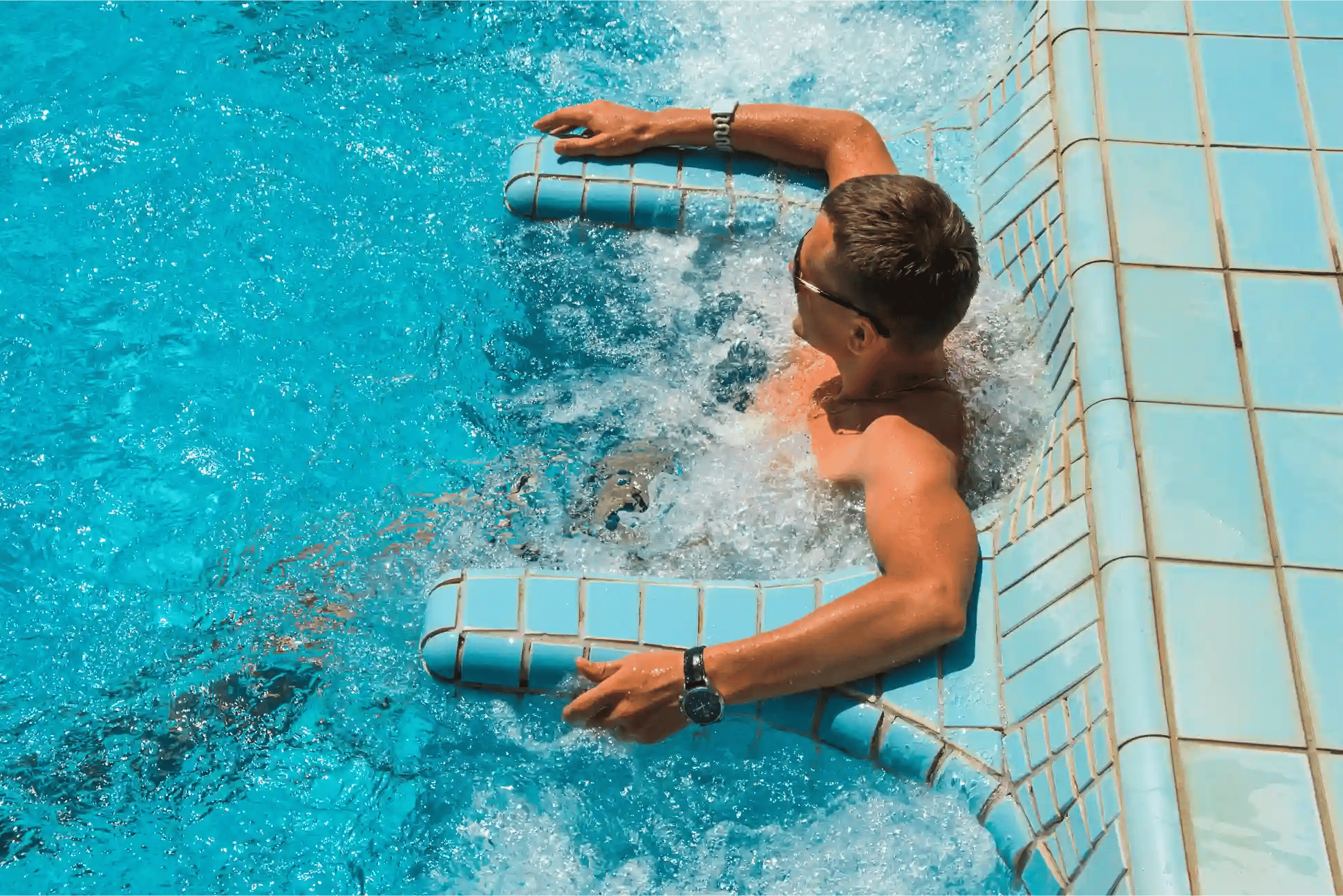Listen to this article
|
TL;DR Water resistance in luxury watches protects against moisture but isn’t permanent—gaskets wear, crowns loosen, and ratings reflect lab tests, not real-life use. A 50m rating may handle splashes, while 200m+ suits diving, but heat, salt, and wear degrade seals over time. Regular servicing preserves resistance, while specialist watch insurance Australia providers may cover water damage if records are up to date. Understanding ratings, care, and insurance ensures your luxury timepiece lasts. |
Water resistance might sound like a feature you'll never test—until you do.
A quick swim. A steamy shower. A splash of champagne at a celebration. Many luxury watches can handle everyday moisture, but there's a big difference between "splash-proof" and "submersible." And the truth is, many high-end timepieces—Rolex, Omega, Cartier, you name it—have reportedly met their end due to water damage their owners didn't see coming.
It's easy to assume that a rating like 50 or 100 metres means your watch is safe to swim in. But those numbers aren't as straightforward as they seem. They're based on lab pressure tests under ideal conditions—not real-life scenarios like hot water, salt spray, or sudden movement. And when moisture gets inside a precision-crafted case? Repairs for water-damaged luxury watches can be complex and costly, depending on the brand, age, and extent of the damage.
If you collect luxury watches or wear just one that matters a lot to you, understanding how water resistance works is more than technical trivia. Knowledge is power when preserving your investment and caring for it long-term. That's why many Australians consider watch insurance to secure cover that accounts for the realities of modern wear.
Together, we'll explore what water resistance actually means (hint: it's not always what your metre rating says), how to care for different styles, and what role specialist insurance could play when the unexpected happens. Whether you're waist-deep in the surf or simply caught in a downpour, your watch deserves better than guesswork.

Table of Contents
- Understanding Water Resistance Ratings
- How Watchmakers Design for Water Resistance
- Common Water Damage Risks Most Owners Overlook
- Watch Insurance and Water Damage
- Choosing Watch Insurance in Australia
- Caring for Your Watch to Keep It Water-Resistant
- Common Questions about Water Resistance and Watch Insurance
- Why Water Resistance Deserves More Attention
Understanding Water Resistance Ratings
What Does "Water Resistant" Actually Mean?
A water resistance rating might seem self-explanatory—until you realise it rarely means what you think.
In the watch world, "water-resistant" doesn't mean waterproof. In fact, no luxury watch is technically waterproof, and the industry avoids using that term altogether. Instead, manufacturers assign ratings in ATM (atmospheres), bars, or metres, each representing how much pressure a watch can handle under ideal test conditions. But these lab environments don't account for daily use, sudden movements, or hot water.
Let's break it down:
|
Rating |
Equivalent Pressure | May Be Safe For | Not Recommended For |
| 3 ATM / 30m | Rain & splashes | Hand washing, light rain | Showering, swimming |
| 5 ATM / 50m | Short immersion | Showering (cool water) | Swimming, diving |
| 10 ATM / 100m | Surface swimming | Pool or ocean swimming (depending on whether it has been rated for salt or chlorinated water) | Snorkelling, high-impact water sports |
| 20 ATM / 200m | Recreational diving | Snorkelling, light scuba diving | Saturation diving |
Important note: These are general guidelines only—always follow manufacturer instructions. These depths don't refer to how deep you can dive. They refer to static pressure—what your watch might experience in a controlled lab, not while catching a wave or doing laps in the pool.
A common myth is that a 100m watch is dive-ready. In reality, most brands reserve that status for 20 ATM (200m) and above. Heat is another quiet culprit—steam from a hot shower or sauna can weaken seals, letting moisture in.
Understanding these ratings is critical if you're shopping for a luxury watch with aquatic plans in mind. It's also why many Australians looking for watch insurance seek cover tailored to how and where they actually wear their pieces, and the accidents that may happen.
How Watchmakers Design for Water Resistance
The Engineering Behind the Rating
Every water resistance rating begins with a feat of micro-engineering. Beneath the dial, high-end watchmakers use a combination of precision design and physical barriers to keep moisture out, at least for a while.
The unsung heroes of water resistance are:
-
Gaskets: These tiny rubber or synthetic rings line the crown, crystal, and caseback, creating pressure seals at key entry points.
-
Screw-down crowns: Unlike push-pull crowns, these screw tightly into the case, reducing the risk of accidental moisture ingress when adjusting time or date.
-
Caseback construction: Solid screw-in casebacks (as seen in many dive watches) offer stronger seals than snap-fit or display casebacks.
Brand differences matter, too. Rolex's Triplock crown system, used in models like the Submariner, features three layers of seals for exceptional resistance. Omega's Naiad Lock system in the Seamaster ensures the caseback always aligns correctly, maintaining both form and function. IWC's Aquatimer combines push-button dive bezels with internal seals to balance ruggedness and refinement.
But even the best designs aren't immune to time. Gaskets degrade, crown threads wear, and everyday wear, from saltwater to sunscreen, can erode components designed to keep water out. Luxury watches require regular servicing to maintain their original resistance ratings.
Are you an outdoorsy type shopping for a watch that matches your lifestyle? You might enjoy this quick read: The Best Luxury Watches for Outdoor Adventurers and Sports Enthusiasts.
Water resistance isn't forever
No matter how high the rating, water resistance diminishes over time. Regular pressure testing and servicing—every 12 to 24 months—help ensure your watch performs as it was built to.

Common Water Damage Risks Most Owners Overlook
What Voids Your Water Resistance
Water resistance isn't a permanent condition; it's a performance rating that depends on how you treat your watch. Many owners unintentionally void that rating without even realising it.
Here are some of the most common culprits:
-
Opening the crown underwater: screw-down crowns lose effectiveness if opened while submerged. Changing the time in the pool? Risky.
-
Adjusting time or date in humid environments: Moisture can sneak in even when it's not visible, especially if seals are worn or compromised.
-
Skipping regular pressure testing: Gaskets naturally degrade. Without annual or biannual testing, you're gambling on seals that might have already failed.
Even everyday behaviour, like rinsing your watch under a tap or wearing it in a sauna, can challenge its factory-set resistance. That's why understanding (and respecting) these limits matters if you want your watch to last.
What happens when a water-resistant watch gets wet?
-
Internal fogging under the crystal
-
Corrosion of hands and movement components
-
Discolouration on the dial or indices
-
Complete movement failure
When Damage Happens
When moisture breaches your watch case, the damage can move fast and is rarely reversible without expert intervention. At first, it may look like minor fog under the glass. But what follows can include:
-
Corroded movements: Rust doesn't take long to form, especially on steel components.
-
Disintegrated gaskets: Once one fails, it compromises the entire case seal.
Dial damage: Even small amounts of water exposure can cause stains, lifted markers, and faded lume.
It's a costly lesson highlighting why regular maintenance matters more than a printed depth rating.
Watch Insurance and Water Damage
Why Water Resistance Affects Insurance Coverage
Water damage may sound like something your watch insurance will automatically cover, but that isn't always the case.
Some policies may exclude damage caused by owner negligence. Under some policies, claims for water damage may not be accepted, especially if the watch hasn’t been serviced regularly or if water entered due to misuse. It’s best to check with your insurer and keep servicing records up to date. Even luxury dive watches with 300-metre ratings aren't exempt if the damage appears preventable.
That's why servicing records matter, especially for high-value pieces. Specialist providers offering watch insurance in Australia sometimes require proof of regular pressure testing for pieces with serious water ratings. This is a way to verify that the watch was maintained within the manufacturer's specs at the time of damage.
Here's the key difference: some home and contents insurance providers treat a luxury watch like any other household item. Providers focused on Australian watch insurance typically understand the nuances of servicing schedules, water-resistance limits, and brand-specific design tolerances.
What to Ask Before You Insure a Watch
Before you finalise a policy, it's worth asking a few water-specific questions to avoid future surprises:
Does the policy cover water-related repairs?
Clarify whether accidental water damage is covered, and under what conditions.
Is documentation required post-servicing?
Ask if you must provide service receipts or pressure test results for your cover to remain valid, or in the event of a claim.
Can you choose your own watch boutique for repairs?
Some policies restrict you to specific repair networks, while others allow you to work with your trusted local horologist.
Let's look at how to stay ahead of these risks by building a care and insurance strategy tailored to how and where you wear your timepiece.

Choosing Watch Insurance in Australia
What Makes a Good Policy for Water-Resistant Watches?
Not every policy is built for the kind of life your watch actually lives. If your timepiece travels, swims, or gets worn daily, your insurance should match that lifestyle.
You may want to start with a replacement policy. You may want a policy that guarantees your watch's worth from day one, not one that leaves you guessing.
Next, check for worldwide cover that includes swimming, diving and daily use. Some policies restrict coverage based on where and how the watch is worn.
And make sure you can choose a brand-authorised repairer if something goes wrong. A luxury watch deserves specialist care, not a generic fix.
Who Offers the Best Watch Insurance in Australia?
Specialist providers like JewelCover may offer policies that cover daily wear (see PDS for terms and limits), worldwide cover and offer fast claims with access to certified repairers.
When comparing options, you may want to look for:
-
A replacement policy
-
Cover that follows you around the world
-
Flexibility to repair through your trusted watch boutique when possible
-
Annual revaluations to keep your policy accurate
Caring for Your Watch to Keep It Water-Resistant
Daily Habits That Extend Water Resistance
Water resistance isn’t a set-and-forget feature—it relies on your daily habits.
-
Skip the sauna. Heat causes gaskets to expand, weakening their seal over time. Hot showers and steam rooms are common culprits in premature seal failure, so be sure to leave your watch at home when enjoying a soak or a steam.
-
Rinse after the ocean. Saltwater corrodes even the toughest materials. A quick rinse in fresh water helps preserve seals and finishes.
-
Keep the crown closed. Opening it—even briefly—exposes the interior to humidity. Only adjust when your watch is dry and in a cool environment.
These simple habits can help your water resistance last far beyond the warranty.
Remember: Even if your watch is waterproof, your leather strap definitely isn't! Find out how to care for a leather watch strap here.
Service Intervals and Testing
Water resistance fades with time, and most watchmakers recommend pressure testing every one to two years, especially before diving holidays or humid Aussie summers.
Service Tip: Schedule checks before summer or after a surf-heavy season to catch issues early.
Consistent servicing protects both your watch and any coverage it’s linked to. Some insurers require service records, especially for dive-rated pieces.

Common Questions about Water Resistance and Watch Insurance
Can I swim with a water-resistant watch?
It depends on the rating.
-
3 ATM / 30 metres: Light splashes only—no swimming.
-
5 ATM / 50 metres: Cold water rinse-safe but not ideal for prolonged submersion.
-
10 ATM / 100 metres or more: Suitable for swimming or snorkelling.
Always check your watch's rating and condition before diving in.
Are water-resistant watches waterproof?
No watch is truly "waterproof." The term "water-resistant" means it can handle limited moisture based on specific pressure tests. Even dive-rated watches can fail if gaskets wear out or crowns aren't sealed properly.
Can water-resistant watches be worn in the shower?
It's generally not recommended. Heat and steam can stress gaskets, even in watches rated to 50 metres. Over time, this weakens the seal and increases the risk of internal damage. Remove your watch before hot showers or saunas.
How to test watch water resistance at home?
You shouldn't. Water resistance testing requires specialised pressure equipment. DIY methods—like submerging your watch in water—can do more harm than good. Visit a certified watchmaker for proper testing every 12–24 months.
How to insure a watch
- Get a valuation from a certified watch specialist.
- Gather documentation, such as purchase receipt, serial number, and servicing history.
- Choose a provider. You may want to choose a specialist provider offering a replacement policy, worldwide cover, and brand-authorised repairs.
Are watches covered on home insurance?
Sometimes, but limits and exclusions could apply. Some home policies have sub-limits for high-value items and may not cover wear, travel, or water damage. Standalone Australian watch insurance may offer broader, more flexible coverage.
Does watch insurance cover water damage?
It depends on the provider and policy. Specialist watch insurance may cover water-related repairs, especially if servicing records are up-to-date and there's no sign of misuse. Always ask about water damage exclusions when comparing options.

Why Water Resistance Deserves More Attention
Water resistance isn't a footnote—it's a feature that shapes how, when, and where you wear your watch. And when misunderstood, it's one of the fastest ways to compromise a timepiece built to last.
From everyday humidity to saltwater exposure, luxury watches face more risk than most owners realise. But with the right knowledge, regular servicing, and insurance that matches how you actually wear your watch, you're staying ahead, not cleaning up after the damage.
Whether your piece is dive-rated or desk-bound, water resistance deserves more than blind trust—it deserves informed care.
Explore cover options designed for collectors and everyday wearers alike—so your timepiece is protected for how you wear it, not just where you keep it.
Get an indicative quote with JewelCover today.




